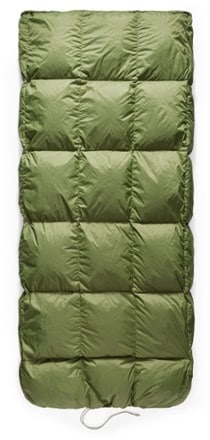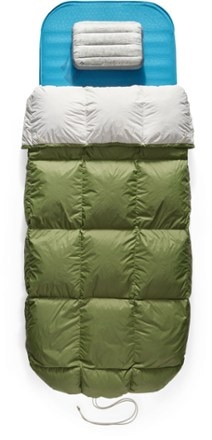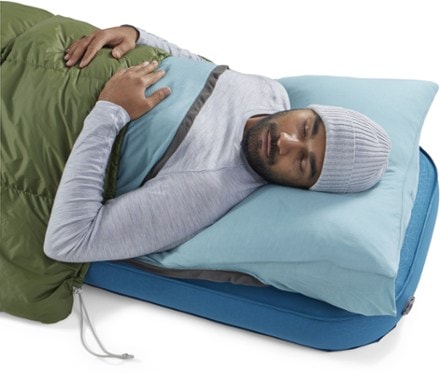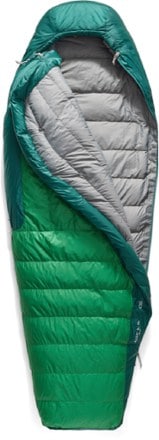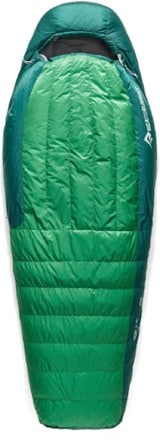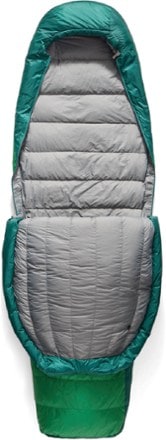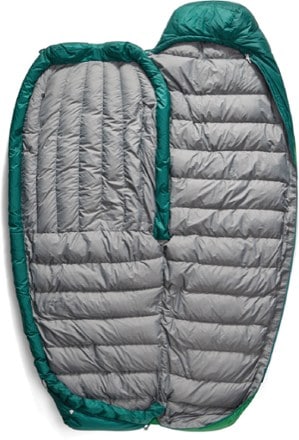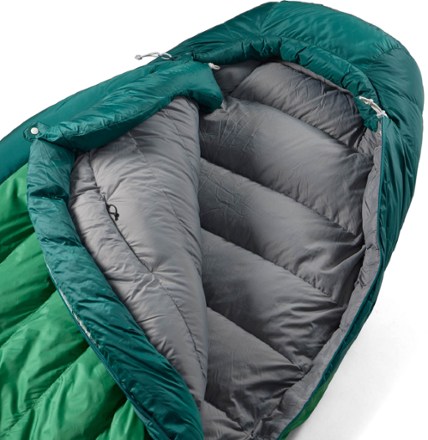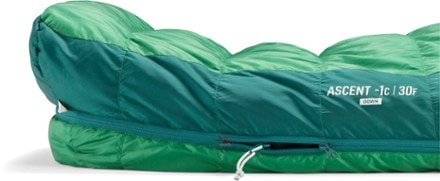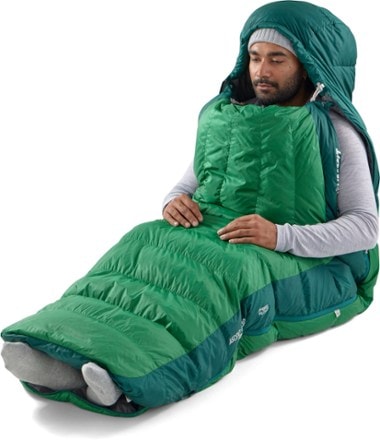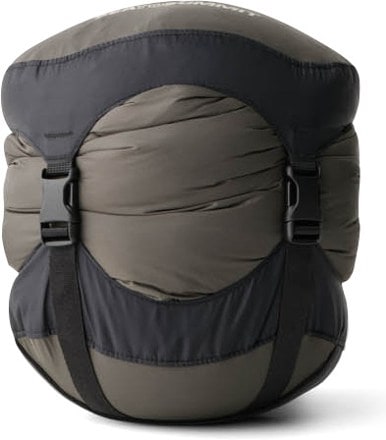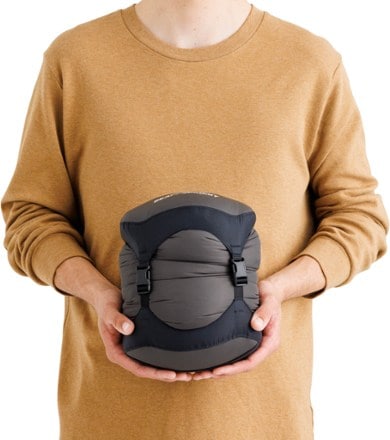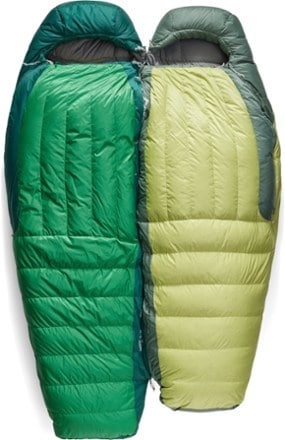Sea to Summit Puffy Sleeping Gear
(2 products)- Left/Right (1)
- Backpacking (2)
- Camping (1)
- 1 to 1.49 (1)
- 1.50 to 2.99 (2)
- Water-Resistant Down (2)
- Top Rated (2)
- Puffy (2)
- Ultralight (1)
- Wearable (1)
- 551 to 650 (1)
- 651 to 750 (1)
- 20 to 39 degrees (1)
- 40 degrees and above (1)
- Mummy (1)
- Rectangular (1)
- Green (2)
- Down (2)
- Sea to SummitTanami 45F Down ComforterTop Rated$205.00 - $310.00(11)11 reviews with an average rating of 4.9 out of 5 starsWeight:1.31 to 2.04 lbsDimensions:82 x 53 in., 82 x 82 in.Insulation Type:Down
- Sea to SummitAscent 30F Sleeping BagTop Rated$429.00 - $459.00(30)30 reviews with an average rating of 4.9 out of 5 starsTemperature Rating:30 FWeight:1.72 to 1.98 lbsInsulation Type:DownFeatures:Water-Resistant Down
Related Expert Advice articles
Do I really need a backpacking-specific bag?
Yes. These sleeping bags are lighter, pack down smaller and are more efficient at keeping you warm compared to ones for camping.
Understand sleeping-bag weight
Insulation type and bag shape affect weight the most. Always consider bags of a similar temperature rating when comparing loads.
Choose the right fit
Many sleeping bags come in regular, long and short sizes. Review the bag's size specs for the best fit.
Consider other features
Draft-blocking details, a snug-fitting hood, extra zippers and even a stash pocket can add more durability, warmth and function.
Read full article: How to Choose Sleeping Bags for Backpacking
How will you be using your liner?
- For backpackers, a mummy-shaped bag liner helps keep your sleeping bag free of dirt and body oils, helping it last longer. A liner can also be used in place of a sleeping bag in hot climates.
For travelers, a rectangular bag liner or travel sheet keeps you separated from bedding of questionable cleanliness or with possible bedbug infestations.
Which liner material is right for you?
- Silk: Very lightweight, compact and insulates in cold weather. Absorbent and breathable in warm weather. Price: moderate to expensive.
- Cotton: Strong, durable and absorbent, but not the lightest or most compact. Price: economical.
- Fleece and microfleece: Warmer, heavier, soft, moisture-wicking and quick-drying, but the mid- and heavyweight varieties are bulky. Price: moderate.
- Synthetics (e.g., CoolMax®): Moisture-wicking, breathable, ideal for humid conditions and stretchy for restless sleepers. Price: moderate.
- Insulated (e.g., Thermolite®): Adds enough warmth to greatly extend the range of a lightweight bag. It dries faster than cotton. Price: moderate to expensive.
Understand temperature ratings
Opt for a sleeping bag with a temperature rating below the lowest nighttime temperature you expect when camping.
Choose a sleeping bag shape
There are four main shapes: rectangular, semirectangular, mummy and double. Generally, you want one that gives you room to stretch.
Select synthetic or down insulation
- Synthetic is more affordable, dries faster and provides warmth when damp.
- Down is lightweight, durable and compresses small.
Consider other features
A waterproof shell, snug-fitting hood, extra zippers and even a stash pocket can add durability, warmth and function.
Read full article: Sleeping Bag Buying Guide: How to Choose the Right One for Camping
Read full article: The 9 Best Sleeping Bags for Camping of 2025 | Staff Picks
Where will you use the pad?
Decide how you’ll use the pad. Weight and packability will matter more if you're backpacking than if you're car camping. If you're winter camping, pick an insulated pad with warmth (or a high R-value).
What are the different types of sleeping pads?
- Air pads. Pros: Comfortable, lightweight and packable. Cons: Generally more expensive. Can be punctured or ripped.
- Self-inflating pads. A combo of open-cell foam and air. Pros: Often quite warm. Made in a variety of thicknesses and styles. Cons: Heavier than a simple foam pad.
- Closed-cell foam pads. Pros: Cheapest option. Almost indestructible. Cons: Not super comfortable.
Decide on the warmth (R-value) you need
- Sleeping pads are rated by R-value; a higher number means more insulation.
- Match your choice to the season and weather.
- Pads with an R-value less than 2.0 are suitable for warm weather whereas those with an R-value 5.5 and greater are ideal for extreme-cold-weather.
What dimension do you need?
- Pads vary by weight, cushioning, length, width, ease of inflation and more. At a minimum, your shoulders and hips need to fit on a pad.
- Regular (typically 72 inches long) and long (typically 78-inch) pads will insulate your legs and feet.
- A short or 3/4-length pad (usually 47 or 48 inches) weighs less and packs smaller.
Read full article: How to Choose the Best Sleeping Pad for Camping and Backpacking
Read full article: The Best Budget Sleeping Pads of 2024: Tested
